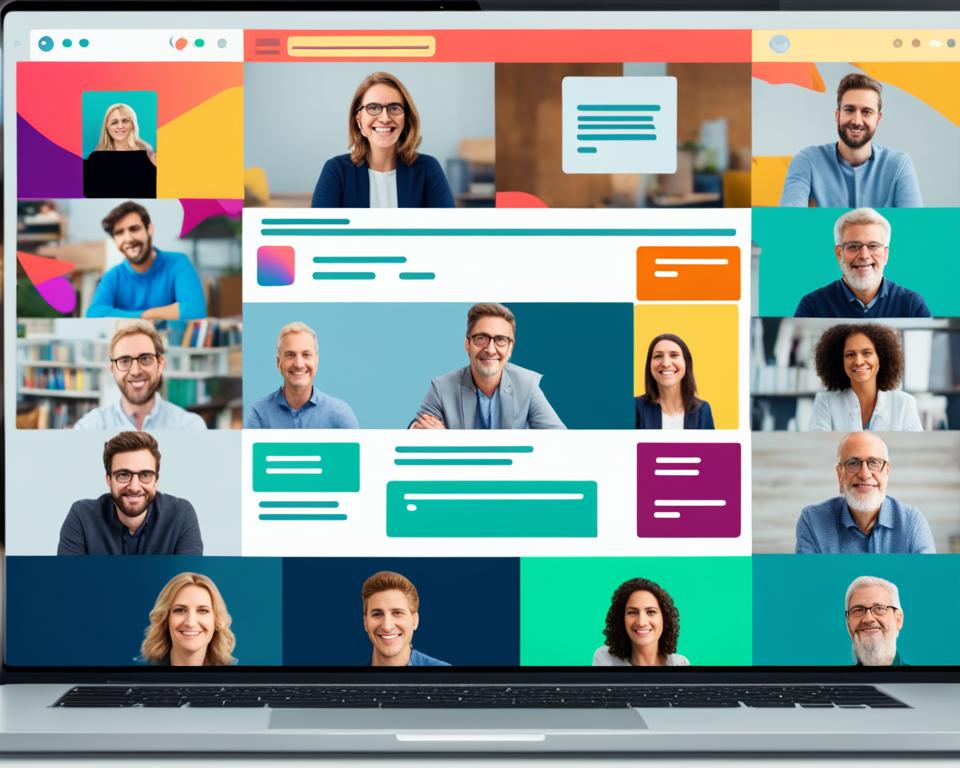Online courses provide a flexible and convenient way to learn new skills and advance in your career. Whether you’re looking to acquire new knowledge, improve your professional expertise, or explore new interests, there are various types of online courses available to suit your needs.
From degree programs to professional development courses, online education offers a wide range of options to choose from. These courses are conducted through virtual platforms, allowing you to access high-quality education from the comfort of your own home or anywhere with an internet connection.
Whether you prefer structured learning programs with specific learning objectives or self-paced e-learning courses that allow you to learn at your own speed, online education has something for everyone.
Key Takeaways:
- Online courses provide a flexible and convenient way to learn new skills and advance in your career.
- There are various types of online courses available, ranging from degree programs to professional development courses.
- Online education allows you to access high-quality education from anywhere with an internet connection.
- You can choose between structured learning programs or self-paced e-learning courses.
- Online courses offer a wide range of options to suit your learning style and goals.
Free Online Courses
Looking to enhance your knowledge and skills without breaking the bank? Free online courses are the answer. These courses cover a wide range of subjects, from fundamental marketing to content marketing, social media marketing, coding, and personal and professional development. Whether you want to sharpen your skills in a specific field or explore new areas of interest, free online courses offer a convenient and cost-effective way to learn.
Reputable institutions offer free online courses that provide certifications upon completion, making them a valuable addition to your resume. By enrolling in these courses, you can gain valuable knowledge, improve your skillset, and increase your chances of professional advancement.
Subjects Covered in Free Online Courses
Free online courses span various subjects and are designed to cater to different interests and skill levels. Some popular subjects covered in these courses include:
- Fundamental Marketing
- Content Marketing
- Social Media Marketing
- Coding
- Personal and Professional Development
These courses are often self-paced, allowing you to learn at your own convenience. Whether you are a beginner or an experienced professional, free online courses provide an opportunity to upskill and stay competitive in today’s fast-paced job market.
With the rapidly advancing technology, online learning has become more accessible than ever. The image above perfectly captures the essence of free online courses, illustrating the diversity of subjects they offer.
Asynchronous and Synchronous Online Courses
Online courses offer a flexible and convenient way for individuals to pursue their educational goals. One of the key distinctions in online learning is between asynchronous and synchronous courses. Understanding the differences between these formats can help students choose the learning approach that best suits their needs.
Asynchronous Online Courses
In an asynchronous online course, students have the freedom to learn at their own pace. These courses do not require real-time interaction with instructors or classmates. Instead, students access course materials, complete assignments, and participate in discussions when it is convenient for them. This flexibility is particularly beneficial for individuals with busy schedules or those who prefer to learn independently.
Asynchronous online courses allow students to:
- Work on assignments and access course materials at their own convenience.
- Study at their own pace without worrying about being available at specific times.
- Take breaks and revisit lessons as needed, ensuring a deeper understanding of the material.
Example: John, a working professional with a hectic schedule, enrolls in an asynchronous online course in digital marketing. He can access the course content and complete the assignments during his free time, making it easier to balance his work and studies effectively.
Synchronous Online Courses
On the other hand, synchronous online courses require students and instructors to engage in real-time communication. These courses typically involve live video or audio sessions, text chats, or virtual classrooms. Students participate in discussions, ask questions, and collaborate with peers and instructors in real-time, creating a more interactive learning experience.
Benefits of synchronous online courses include:
- Immediate feedback and clarification on course material through real-time discussions.
- Opportunities for collaboration and networking with classmates and instructors.
- A sense of structure and routine that can be beneficial for some learners.
Example: Sarah, an aspiring graphic designer, enrolls in a synchronous online course in design principles. She attends live sessions where the instructor provides demonstrations, and she can ask questions in real-time. The interactive nature of the course enhances her learning experience and allows her to receive immediate feedback on her work.
Distance Learning Courses
Distance learning courses encompass both asynchronous and synchronous formats. These courses offer the flexibility of asynchronous learning while also providing opportunities for real-time interaction. Students have the freedom to access course materials and complete assignments at their own pace, while still engaging in live sessions or discussions with their peers and instructors at specified times.
The benefits of distance learning courses include:
- Flexibility to learn at your own pace.
- Opportunities for real-time interaction with instructors and classmates.
- The ability to balance work, personal commitments, and studies effectively.
Example: Emily, a full-time working professional, enrolls in a distance learning course in project management. She can complete the course assignments at her own pace, utilizing the asynchronous format. Additionally, she attends live sessions to actively participate in group discussions and gain insights from experienced professionals in the field.
Choosing between asynchronous and synchronous courses depends on individual learning preferences, schedules, and goals. Some individuals may benefit from the flexibility of asynchronous courses, while others may thrive in the real-time interactions of synchronous courses. Distance learning courses provide a balanced approach, offering the best of both worlds.

Hybrid Courses
Hybrid courses, also known as blended courses, offer a unique learning experience that combines in-person and online interaction. These courses are designed to provide students with the benefits of both traditional classroom settings and the flexibility of online learning.
In hybrid courses, students have the opportunity to meet their instructors and peers in person several times throughout the semester. These face-to-face sessions allow for immediate feedback, discussions, and hands-on activities that enhance the learning process. The in-person interaction fosters a sense of community and promotes collaboration among students.
Between the in-person sessions, hybrid courses utilize online platforms for communication and course materials. This allows for continuous engagement and interaction with the course content, even outside of the physical classroom. Students can access lectures, assignments, resources, and engage in discussions at their own pace and convenience.
Hybrid courses are a popular choice for individuals who prefer a blend of traditional and online learning methods. They provide the flexibility to balance work, personal commitments, and academic pursuits. Students can benefit from the structure and support of in-person sessions while still enjoying the convenience and accessibility of online learning.
Advantages of Hybrid Courses:
- Flexibility: Hybrid courses offer a flexible schedule by combining in-person and online learning methods, allowing students to manage their time effectively.
- Meaningful Interaction: The in-person sessions in hybrid courses provide opportunities for direct interaction with instructors and fellow classmates, fostering a deeper understanding of the course content.
- Accessible Learning Materials: Online platforms used in hybrid courses provide 24/7 access to course materials, allowing students to review lectures, readings, and resources whenever needed.
- Enhanced Engagement: The combination of in-person and online interaction keeps students actively engaged in the learning process, promoting better understanding and retention of course content.
- Collaborative Learning: Hybrid courses encourage collaboration among students through in-person discussions and online communication tools, promoting the development of teamwork and critical thinking skills.
Overall, hybrid courses offer a balanced approach to learning by combining the best aspects of traditional and online education. They provide the flexibility and convenience of online learning while still allowing for in-person interaction and engagement. Hybrid courses cater to the diverse needs of students and offer a dynamic and effective learning experience.
Providing Continuity During Interruptions
In the fast-paced world of online education, interruptions can occur due to various reasons such as technical glitches, natural disasters, or other unforeseen circumstances. When these disruptions happen, it is crucial to have a solid plan in place to ensure continuity in online courses and keep students informed. Effective communication and clear strategies are the key to successfully navigating these challenges and minimizing disruption to the learning process.
Keeping Students Informed
During an interruption, keeping students informed about the situation and the steps being taken to restore normalcy is of utmost importance. Proactive messaging should be employed to provide timely updates and address any concerns or questions that students may have. By keeping the lines of communication open, instructors can help ease student anxiety and foster a sense of trust and confidence in the educational process.
In addition to regular updates, instructors should establish clear communication channels through which students can reach out for assistance or clarification. This can include email, discussion boards, or a designated online communication platform. By providing students with multiple avenues to communicate, instructors can ensure that nobody feels left behind or disconnected during the interruption.
Furthermore, it is essential to simplify the communication process to avoid overwhelming students with complex instructions or requirements. Clear and concise messages, along with step-by-step guidance, can help students stay focused and understand their responsibilities during the interruption. This can also include providing easily accessible FAQs or a comprehensive guide addressing common concerns to streamline the communication process.
Establishing a Communication Plan
Having a well-defined communication plan is crucial for maintaining continuity during interruptions. This plan should outline how and when instructors will communicate with students, as well as the preferred methods for students to reach out for support. By setting clear expectations around communication, students can feel confident that they will receive timely updates and assistance when needed.
A communication plan should also include alternative methods for distributing course materials in case the regular channels are disrupted. This can involve utilizing file sharing platforms, uploading materials to a learning management system, or providing offline access to relevant resources. By having contingency measures in place, instructors can ensure that students have uninterrupted access to the necessary materials to continue their learning journey.
Communication Channels during Interruptions
| Communication Channels | Benefits |
|---|---|
| Direct and personalized communication | |
| Discussion Boards | Collaborative environment for student interaction |
| Online Communication Platform | Real-time communication and discussion |
| File Sharing Platforms | Alternative methods for distributing course materials |
| Learning Management System (LMS) | Centralized access to course content and resources |
By utilizing various communication channels and establishing a comprehensive plan, instructors can ensure that continuity is maintained in online courses despite any interruptions that may occur. Keeping students informed, simplifying communication, and providing alternative methods for distributing materials are essential elements in navigating unexpected disruptions and ensuring a seamless learning experience for all.

Creating and Curating Content
When it comes to online courses, creating and curating high-quality content is crucial. Course creators have the option to develop their own course materials or curate existing resources from reputable sources. By incorporating a combination of both, instructors can provide students with a well-rounded and comprehensive learning experience.
Creating online course content allows instructors to tailor the material to their specific teaching objectives and the needs of their students. They can develop multimedia resources such as audio and video lectures to enhance engagement and comprehension. By leveraging these interactive tools, instructors can create a dynamic learning environment that fosters active participation and knowledge retention.
However, developing content from scratch can be time-consuming, especially for instructors who have a limited amount of time or resources. In such cases, curating course materials becomes an effective alternative. By carefully selecting and organizing readings, websites, and videos from reliable sources, instructors can leverage existing content to supplement their own materials.
Benefits of Curating Course Materials
Curating course materials offers several advantages. Firstly, it saves time for instructors by utilizing pre-existing resources that have already been vetted for quality. Secondly, it provides students with a diverse range of perspectives and insights that may not be readily available in a single-source approach. Lastly, curating content allows instructors to tap into multimedia resources from experts in the field, providing students with a more engaging and immersive learning experience.
Curating course materials is like being a curator in a museum. It involves carefully selecting and arranging content to create a cohesive and enriching learning experience for students.
Utilizing Multimedia Resources
One of the key aspects of creating and curating course content is leveraging multimedia resources. Multimedia content, including images, videos, and audio, can enhance the learning experience by providing visualizations, real-life examples, and engaging storytelling. They help to facilitate understanding and keep students actively involved in the learning process.
With the advancements in technology, there are various tools available for instructors to create multimedia content. These tools enable them to record audio and video lectures, create interactive presentations, and design visually appealing graphics. By incorporating these multimedia resources, instructors can effectively communicate complex concepts and cater to different learning styles.
To illustrate the importance of multimedia resources in online courses, take a look at the following image:
| Benefits of Multimedia Resources | Examples of Multimedia Resources |
|---|---|
|
|
By incorporating multimedia resources into online courses, instructors can create an immersive learning experience that caters to the diverse needs and preferences of their students.
Fostering Collaboration in Online Courses
Collaboration is a crucial element in online courses as it promotes a sense of community and enriches the learning experience. To create an environment conducive to collaboration, instructors need to establish clear communication guidelines, provide opportunities for student interaction, and leverage the benefits of both asynchronous and synchronous tools.
Communication Guidelines
Establishing communication guidelines is essential for effective collaboration in online courses. By clearly communicating expectations and guidelines, instructors can ensure that students understand how they are expected to interact with each other and engage in collaborative activities. This includes guidelines for participation, respectful communication, and timely responses.
Opportunities for Student Interaction
Creating opportunities for student interaction is vital to foster collaboration in online courses. Discussion boards, group projects, and peer review assignments are effective ways to encourage active engagement and shared learning experiences. These activities enable students to exchange ideas, discuss course concepts, and collaborate on projects, mimicking the collaborative nature of a traditional classroom setting.
Asynchronous and Synchronous Tools
To facilitate collaboration, instructors can leverage both asynchronous and synchronous tools. Asynchronous tools, such as discussion boards and online forums, allow students to interact and contribute at their own convenience, promoting continuous engagement beyond scheduled class sessions. Synchronous tools, such as web conferencing and live chat, enable real-time communication and encourage immediate feedback, fostering a sense of connection and community among students.
“Collaboration is the key to success in online courses. By providing students with avenues for interaction and setting clear guidelines, instructors can create an engaging and collaborative learning environment.”
-Dr. Emily Johnson, Educational Consultant
| The Benefits of Collaboration in Online Courses |
|---|
| Enhanced understanding of course material through discussions and shared perspectives |
| Opportunity for students to learn from and support each other |
| Development of critical thinking and problem-solving skills |
| Promotion of active engagement and accountability |
| Cultivation of a sense of community and belonging |
Collaboration is a cornerstone of effective online learning. Through clear communication guidelines, opportunities for student interaction, and the use of asynchronous and synchronous tools, instructors can foster a collaborative and engaging learning environment that enhances the overall educational experience.

Assessing Students in Online Courses
Assessing students in online courses is an essential aspect of evaluating their progress and understanding. It presents unique challenges but plays a crucial role in ensuring effective learning outcomes. There are various methods available for assessing students in online courses, including assignment options and online exams.
Assignment Options
Assignments provide an opportunity for students to apply their knowledge and demonstrate their understanding of the course material. In online courses, it is important to provide clear instructions for assignments and establish reasonable deadlines for submission. To avoid overwhelming email attachments, document transfer methods can be used to facilitate the submission of assignments, ensuring a smooth and organized process.
Online Exams
Online exams serve as a means to test students’ knowledge and comprehension of the course content. They can be administered using various platforms and tools, such as online examination software. To ensure the integrity of online exams, it is important to implement measures like randomized question banks and proctoring services, if necessary. Clear instructions and time limits should be provided to students to ensure a fair testing environment.
When assessing students in online courses, it is crucial to communicate grading criteria transparently. Clear and comprehensive feedback should be provided to help students understand their strengths and areas for improvement. Regular and constructive communication with students plays a significant role in motivating them and fostering a positive learning environment.
Overall, assessing students in online courses requires careful planning, clear instructions, and effective communication. By utilizing assignment options and online exams, instructors can evaluate students’ progress and understanding, ensuring a meaningful and productive learning experience.
Conclusion
Online courses provide a myriad of learning options that cater to different individuals’ needs and preferences. The benefits of online courses, such as flexibility, convenience, and access to a diverse range of subjects, make them an appealing choice for those seeking to acquire new skills, advance their careers, or explore new subjects.
The future of online education looks promising as technology continues to advance. With the emergence of new tools and platforms, the online learning experience is expected to become even more immersive and interactive. These advancements will further enhance the learning outcomes and engagement of students.
Thanks to online learning options, individuals no longer need to be bound by physical constraints or traditional classroom settings. They can pursue their educational interests and goals at their own pace and convenience. With the growing popularity of online courses, the range of subjects and qualifications available continues to expand, providing individuals with more opportunities to enhance their knowledge and skills.
As the demand for lifelong learning increases, online courses have become an integral part of the educational landscape. The benefits they offer, along with the continuous innovation in online education, ensure that they will play a fundamental role in shaping the future of learning.
FAQ
What types of courses are available online?
Online courses provide a wide range of options, including online education courses, online learning programs, and e-learning courses. These courses cover various subjects and can be taken for personal or professional development.
Are there any free online courses available?
Yes, there are free online courses offered by reputable institutions. These courses cover subjects such as marketing, coding, personal and professional development, and more. Upon completion, you can receive certifications for these courses.
What are asynchronous and synchronous online courses?
Asynchronous courses are self-paced and do not require real-time interaction. Students can complete assignments and access course materials at their convenience. Synchronous courses, on the other hand, involve real-time communication between students and instructors through text, video, or audio chat.
What are hybrid courses?
Hybrid courses combine in-person and online interaction. These courses typically have both face-to-face sessions and online communication. They provide flexibility while still allowing for in-person engagement and interaction.
How can I provide continuity during interruptions in online courses?
It’s important to establish effective communication plans, including proactive messaging and reducing complexity. Clear communication should be maintained, including how and when to communicate, alternative methods for distributing course materials, and how students can reach instructors.
How can I create and curate content for online courses?
Course creators can develop their own content or curate existing resources such as readings, websites, and videos. There are various tools available to create multimedia content, including audio and video lectures, to provide a comprehensive learning experience.
How can collaboration be fostered in online courses?
Collaboration can be facilitated through asynchronous tools like discussion boards and synchronous tools like web conferencing. Instructors should communicate collaboration expectations, provide opportunities for student interaction, and establish clear communication guidelines to enhance collaboration.
How can students be assessed in online courses?
Assignments can be submitted through document transfer methods to avoid overwhelming email attachments. Online exams can also be conducted to test students’ knowledge and comprehension. Clear instructions and grading criteria should be provided to students for effective assessments.
What are the benefits of online courses?
Online courses offer flexibility, convenience, and access to a wide range of subjects. They allow individuals to acquire new skills, advance in their careers, and explore new subjects. The future of online education looks promising with the advancement of technology and the emergence of new tools and platforms.





